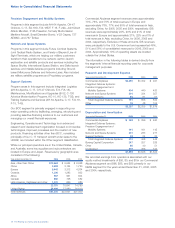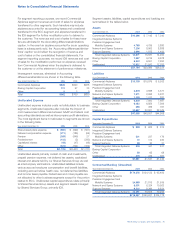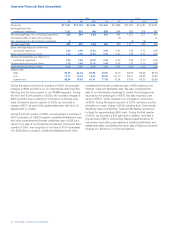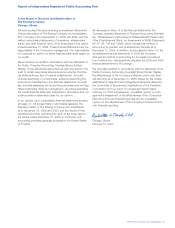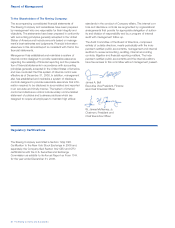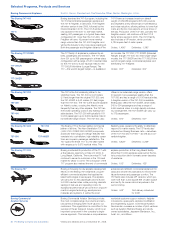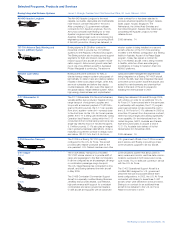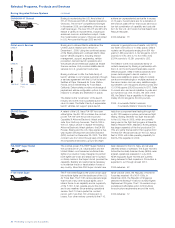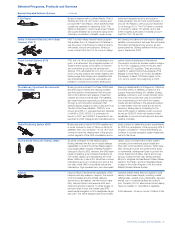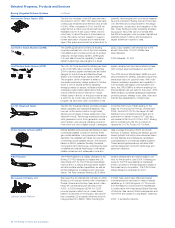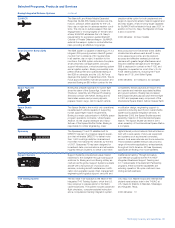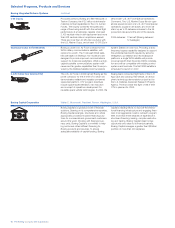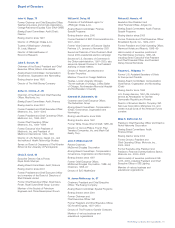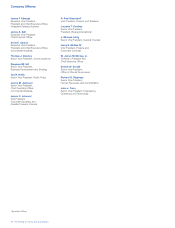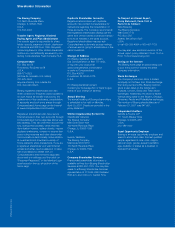Boeing 2006 Annual Report Download - page 90
Download and view the complete annual report
Please find page 90 of the 2006 Boeing annual report below. You can navigate through the pages in the report by either clicking on the pages listed below, or by using the keyword search tool below to find specific information within the annual report.
88 The Boeing Company and Subsidiaries
Selected Programs, Products and Services
Joint Tactical Radio System (JTRS) The U.S. Air Force awarded the Boeing-led team
a 25-month $80 million contract in September
2004 to develop system architectures and initial
designs for the Airborne and Maritime/Fixed
Station Joint Tactical Radio System (AMF JTRS).
The program, which underwent a series of
successful preliminary design reviews in October
2006, is one of several aimed at satisfying
emerging needs for secure, multiband/multinode
software-programmable digital radios that pro-
vide an Internet protocol network for mobile
military users in the air, on the ground and at sea.
A joint U.S. Air Force, Navy and Army effort, the
program will next enter open competition in the
system development and demonstration phase,
with contract award anticipated in July 2007.
The JTRS Ground Mobile Radio (GMR) is a joint
service initiative to develop software-programma-
ble tactical radios for ground forces. With multi-
channel, wideband operations and capability to
communicate with legacy communication sys-
tems, the JTRS GMR is a network-enabling tool
that warfighters will use well into the future. JTRS
GMR will allow complete battlespace awareness
providing secure, wireless voice, data, video and
Internet-like capabilities for mobile forces.
KC-767 Advanced Tanker The KC-767 Advanced Tanker provides unrivaled
tanker capability and operational flexibility. This
low-risk, multi-mission solution is right-sized,
allowing more tankers in fewer bases and more
tankers in the air. Technology advances include a
sixth-generation boom, third-generation remote
vision system, new wing air refueling pods and
hose drum unit, and a digital cockpit. Leveraging
more than 500 hours of flight testing on the
Italian Air Force’s first KC-767 (as of December
2006), the first KC-767 for the Japan Air Self-
Defense Force completed its first flight and is
scheduled for delivery in early 2007. Italy also
will receive its first two KC-767s in 2007. Boeing
also is competing for the KC-X contract to
replace the U.S. Air Force’s KC-135 fleet.
Mobile Satellite Ventures (MSV) Mobile Satellite Ventures awarded Boeing a major
commercial satellite contract in 2006 for three
geo-mobile satellites. Using space and terrestrial
elements, the satellites will create the world’s first
commercial mobile satellite service. The network,
based on MSV’s patented Ancillary Terrestrial
Component (ATC) technology, combines the best
of satellite and cellular technology. It will deliver
reliable, advanced and widespread voice and
data coverage throughout North and South
America. In addition, Boeing will develop ground-
based systems that will provide advanced beam
forming flexibility and interference cancellation
unprecedented in commercial satellite systems.
These technological advances will allow MSV
optimal deployment of its ATC technology and
spectrum utilization.
P-8A Poseidon The P-8A Poseidon is a military derivative of the
Boeing 737-800 designed to replace the U.S.
Navy’s fleet of P-3s. The P-8A will dramatically
improve the U.S. Navy’s anti-submarine warfare
and anti-surface warfare capabilities, as well as
armed intelligence, surveillance and reconnais-
sance. The Navy awarded Boeing a $3.9 billion
System Development and Demonstration con-
tract for the aircraft in June 2004. A Boeing pro-
posal for the P-8I was selected in December
2006 to proceed to the field evaluation phase of
the Indian navy’s competition. The P-8A Critical
Design Review is scheduled for 2007.
Sea Launch Company, LLC
Odyssey
Launch Platform
Sea Launch is an international company in which
Boeing is a 40-percent partner with companies in
Russia, Ukraine and Norway. Sea Launch offers
heavy-lift commercial launch services in the
4,000- to 6,000-kilogram (8,818 to 13,228
pounds) payload class from an ocean-based
platform positioned on the Equator. Sea Launch
has completed 22 successful missions since its
inaugural launch in March 1999, including five
in 2006. Sea Launch also offers land-based
commercial launch services for medium-weight
satellites up to 3,500 kilograms (7,716 pounds)
from the Baikonur Cosmodrome in Kazakhstan,
in collaboration with International Space Services
of Moscow. Sea Launch World Headquarters and
Home Port are located in Long Beach, California.
2006: 5 successful missions
Boeing Integrated Defense Systems continued
International Space Station (ISS) The first two modules of the ISS were launched
and joined in orbit in 1998. The station has been
continuously inhabited since the first crew arrived
in 2000. When completed in 2010, the ISS will
weigh almost a million pounds and will have a
habitable volume of 425 cubic meters (15,000
cubic feet), or about the size of a five-bedroom
home. ISS crews conduct research to support
human exploration of space and to take advan-
tage of the space environment as a laboratory for
scientific, technological and commercial research.
As prime contractor, Boeing built all of the major
U.S. elements and is responsible for the design,
development, construction and integration of the
ISS. Today, Boeing provides sustaining engineer-
ing support. About the size of a football field,
the ISS is the largest, most complex international
scientific project in history and humankind’s
largest adventure in space to date.
Joint Direct Attack Munition (JDAM) The JDAM guidance kit converts an existing
unguided warhead into one of the most capable,
cost-effective and combat-proven air-to-surface
weapons, revolutionizing warfare. JDAM gives
U.S. and allied forces the capability to reliably
defeat multiple high-value targets in a single
pass, in any weather, with minimal risk to the
aircraft. More than 170,000 JDAMs have
been delivered.
2006 deliveries: 31,426


